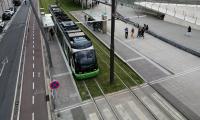The green transition calls for a new approach to infrastructure decision-making
In Denmark, a recent example of this is the socalled “Infrastructure Plan 2035”. Although it contains measures to reduce emissions, there are also many projects that are pulling in the wrong direction. And in the absence of a plan to reduce the sector's emissions in line with Denmark’s statet goal of climate neutrality by 2045, Infrastructure Plan 2035 conflicts with our climate goals. This is nothing special, though. Examples of similar inconsistencies between climate targets and actual decisions can be found from other countries.
CONCITO recommends
- In the idea phase: The foundation for being able to prioritize must be in place
- In the decision phase: Improved and a more transparent basis for decision-making is needed
- In the implementation phase: More planning and re-planning is needed
- Now: Put Infrastructure Plan 2035 on hold
In Wales, however, the government has ended this inconsistent approach. Not only because of climate considerations, but also for economic reasons: road construction is expensive. And if the infrastructure projects are motivated by a traffic forecast that is not consistent with the climate goals, it could be a poor investment. The Welsh Government therefore set up a “Roads Review Panel” in 2021 with the task of formulating a general road construction policy, consistent with Wales' climate targets and transport strategy, and of applying the policy to the (then) current portfolio of road projects.
In February 2023, the Welsh Government largely adopted the recommended principles and incorporated these into an update of the National Transport Delivery Plan.
CONCITO has therefore analysed the climate issues posed by the current Danish approach to infrastructure decisions, seen through 3 lenses:
-
The underlying assumptions in the form of, for example, strategic goals/frameworks for decision-making, pricing of CO2-emissions, etc.
-
The administrative procedures in the form of, for example, forecasting and cost-benefit analysis.
-
The political processes related to transport infrastructure decisions.
Also, we investigate the decision-making cycle of infrastructure planning, from the idea phase, through the decision-making phase to the implementation phase.
Based on the analysis, CONCITO recommends that a procedure for climate-consistent infrastructure planning should be adopted, as part of a much-needed national mobility strategy. Based on Wales' work, we point to several concrete improvements that we believe it would be important for such a procedure to include, to address the shortcomings and inadequacies identified in the analysis.
Read the whole analysis here (in Danish).
In the idea phase: The foundation for being able to prioritize must be in place
First and foremost, it should be ensured that projects and other decisions follow a strategic direction in the form of e.g. a mobility strategy. As we currently lack this, it should be developed. The strategy would benefit from having principles similar to Wales's – in the analysis we propose the following for a start: Investments in new infrastructure are legitimate for projects that...
-
Promotes the use of healthy and resource-efficient modes of transport and that overall reduces CO2 emissions from the transport sector.
-
Improves road safety through initiatives that have limited CO2 emissions from construction.
-
Adapts (reinforces / transforms/cuts) the transport system so that it is resilient against the climate changes we will inevitably have.
-
Provides access to jobs and other necessities through healthy and resource-efficient modes of transport.
In addition, resources should be allocated for ongoing qualification of new wants or needs, so that projects can be analysed before they are included in political decision-making processes.
Provides access to jobs and other necessities through healthy and resource-efficient modes of transport.
Adapts (reinforces / transforms/cuts) the transport system so that it is resilient against the climate changes we will inevitably have.
Improves road safety through initiatives that have limited CO2 emissions from construction.
In the decision phase: Improved and a more transparent basis for decision-making is needed
Current analytical methods and assumptions should in a number of ways be updated to reflect Denmark's climate goals. For example, by using transport sector targets for CO2 emissions from both traffic and infrastructure construction, and by consistent pricing of CO2. This should be complemented by improved, uniform decision-making documentation, needed for political negotiations. This is to ensure that policy decisions can be taken in a way that they are consistent with the agreed climate targets and the adopted mobility strategy.
Because we do not live in technocracy, there must be room for political deviation from the otherwise agreed principles and strategies. However, it is then essential – climate-wise, economically and democratically – that the rationale for this deviation is clearly stated.
In the implementation phase: More planning and re-planning is needed
Even if a project has been analysed and then politically decided, it should – even in the implementation phase - be completely acceptable to revise plans, due to new/changed knowledge. Both administratively by allocating funds/time buffers to be able to reduce CO2 emissions from construction by postponing and/or spending a little extra DKK on reducing emissions. And politically, in a way that agreements and culture allow decision makers to regularly assess whether the planned projects still make sense, and – without drama – stop them if this is not the case.
Now: Put Infrastructure Plan 2035 on hold
A natural consequence of the above is that the construction projects of the Infrastructure Agreement should be put on hold. The agreement was not made on a fully informed basis (e.g. not including/pricing CO2 from construction) and as seen in, for example, the latest development in the economy for stage 3 of the Kalundborg motorway, the cost-benefit ratio is significantly worse. Once a mobility strategy is in place and new decision-making processes are in place as recommended above, projects can be reassessed.





